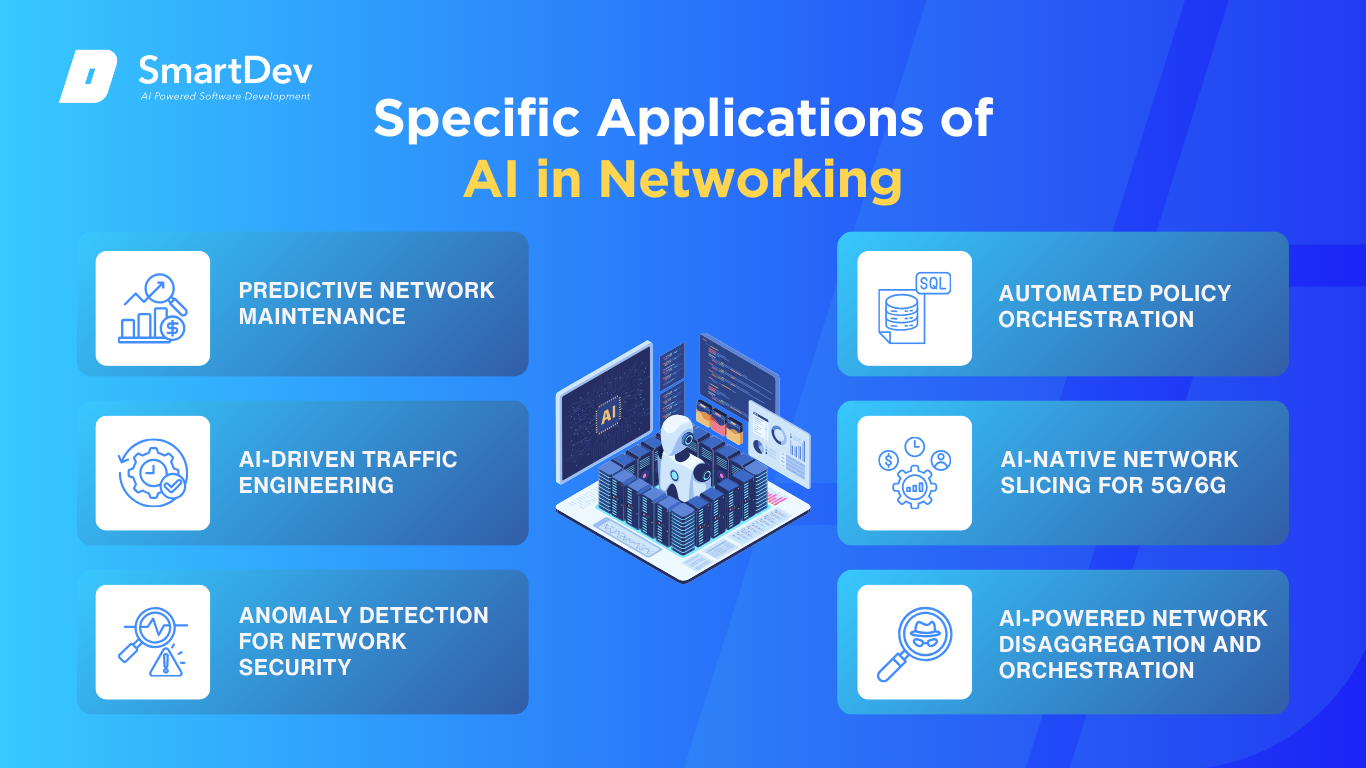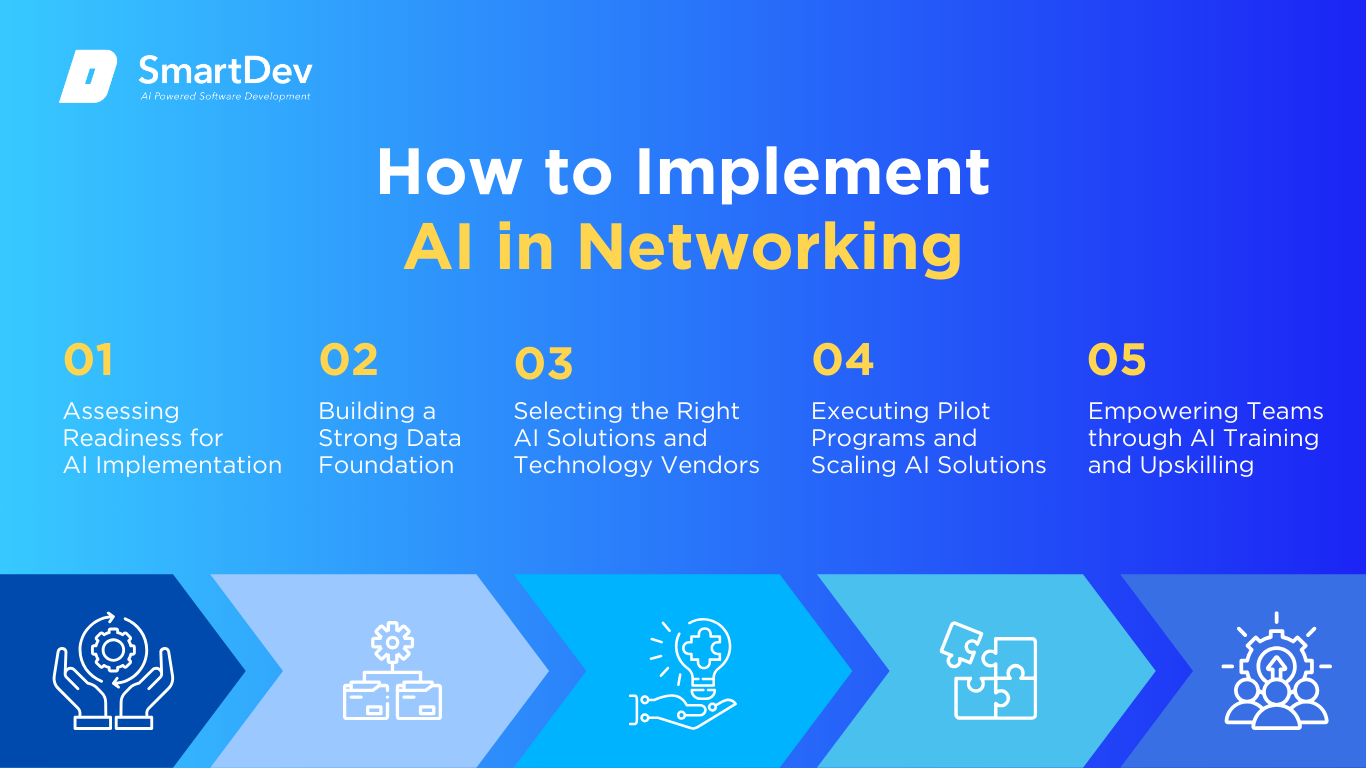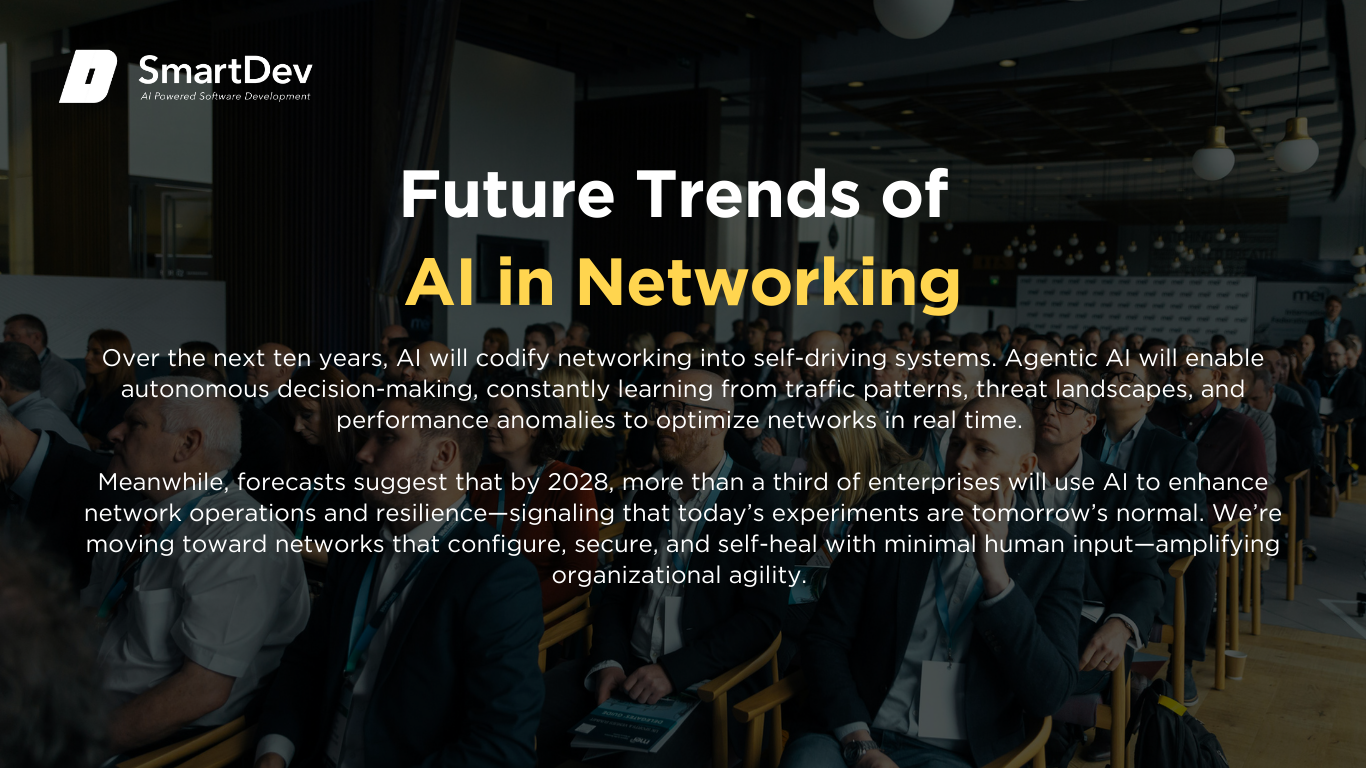Introduction
Networking teams face escalating demands—exploding data traffic, complex infrastructure, and expectations for real-time service. Artificial Intelligence (AI) emerges as a game-changer, automating operations, boosting resilience, and enhancing threat detection.
This comprehensive guide explores AI use cases in networking, delivering concrete insights, real-world applications, and strategic value for your enterprise.
What Is AI and Why Does It Matter in Networking?
 Definition of AI and Its Core Technologies
Definition of AI and Its Core Technologies
Artificial Intelligence (AI) refers to computer systems that perform tasks traditionally requiring human intelligence—learning, reasoning, decision-making—leveraging technologies like machine learning (ML), natural language processing (NLP), and computer vision. These systems enable automation, pattern recognition, and predictive capabilities.
In the context of networking, AI applies ML, analytics, and intelligent automation to optimize configuration, monitoring, and security across infrastructure. It delivers proactive insights, accelerates incident response, and drives operational efficiency. For instance, AI-powered tools can triage root causes, forecast failures, and suggest remediation—with speed and accuracy unmatched by manual processes.
Want to explore how AI can transform your sector? Discover real-world strategies for deploying smart technologies in networking. Visit How to Integrate AI into Your Business in 2025 to get started today and unlock the full potential of AI for your business!
The Growing Role of AI in Transforming Networking
AI is reshaping networking by automating complex operations and elevating strategic agility. First, AI-driven traffic optimization and intent-based networking (IBN) enable dynamic traffic routing based on real-time usage patterns, improving efficiency and reducing latency.
Second, predictive monitoring enhanced by telemetry and ML allows networks to anticipate hardware failures or congestion before they cause outages. Self-healing networks powered by Software-Defined Networking (SDN) can automatically adjust to maintain performance.
Third, agentic AI—systems that learn, act autonomously, and adapt in real time—are shifting network operations from reactive to proactive modes. These digital agents can manage routing, detect anomalies, and optimize resources without human intervention.
Key Statistics or Trends in AI Adoption in Networking
AI is increasingly embedded into network infrastructure. Cisco recently reported over $2 billion in AI infrastructure orders for fiscal 2025—more than double its expectations—and attributes this surge to growing AI demands from cloud providers.
At the same time, the “plumbing” of data centers—networking—is under heightened strain. AI-specific workloads require enhanced bandwidth and low latency; as a result, demand for upgraded network hardware is accelerating.
Technologies like Network Detection and Response (NDR) are also evolving. AI-driven NDR tools detect abnormal behaviors in real time, prioritize alerts by risk, and aid analysts with recommendations—offering both visibility and automation in threat response.
Business Benefits of AI in Networking
AI delivers tangible business value by addressing critical challenges—from downtime to security gaps. Here are five high-impact benefits:
 1. Intelligent Traffic Management & Load Balancing
1. Intelligent Traffic Management & Load Balancing
AI systems analyze real-time usage patterns and network performance to adjust traffic distribution dynamically. Intent-based networking helps prioritize critical applications and avoid congestion, improving throughput and reliability.
This means your network can scale and adapt without manual configuration, reducing latency and optimizing resource allocation during peak loads.
2. Proactive Monitoring and Predictive Maintenance
AI-driven monitoring tools use telemetry data to spot deviations, anticipate hardware degradation, and trigger preemptive maintenance. Networks become self-healing, reducing outages and reactive firefighting.
As a result, you safeguard uptime, cut repair costs, and free engineers to focus on innovation.
3. Enhanced Security with Real-Time Detection
AI enhances security through automated anomaly detection—identifying threats like lateral movement or exfiltration by recognizing behavior beyond signature rules. NDR platforms further prioritize alerts based on impact and assist analysts with response steps.
Thus you strengthen protection while reducing analyst fatigue and false positives.
4. Faster Troubleshooting and Incident Remediation
AI tools like event correlation engines and automated troubleshooting guidance quickly isolate root causes, cutting down resolution time. These systems predict issues before users report them.
The upshot: improved service quality, reduced downtime, and lower support costs.
5. Capacity Planning and Resource Forecasting
By analyzing historical traffic trends, AI enables accurate capacity planning—forecasting when to scale infrastructure, provisioning bandwidth, or upgrade equipment.
This proactive foresight aligns investment with business needs, avoiding both under- and over-provisioning.
Challenges Facing AI Adoption in Networking
While AI offers considerable advantages, real-world deployment involves navigating five key challenges:
 1. Data Quality and Fragmentation
1. Data Quality and Fragmentation
Effective AI demands high-volume, high-fidelity telemetry and logs. However, data often resides in disparate systems—legacy equipment, siloed tools, or inconsistent formats. AI models trained on poor or incomplete data deliver unreliable insights, increasing risk of misconfiguration or misclassification.
Robust data governance, standardized telemetry collection, and unified logging are prerequisites to drive trustworthy AI outcomes.
Siloed systems and scattered data can cripple decision-making and slow growth. Discover how AI is helping organizations unify, clean, and unlock value from their data faster and smarter. Explore the full article to see how AI transforms data chaos into clarity.
2. Integration with Existing Network Systems
AI platforms must mesh with legacy hardware, multi-vendor environments, and existing orchestration tools. Incompatibility risks fragmentation, operational overhead, or network instability.
Mitigation requires modular AI systems, open APIs, and phased rollout through pilot or lab environments to ensure compatibility and minimize disruption.
3. Autonomy, Oversight, and Trust
Agentic AI systems make independent decisions—like adjusting routes or isolating anomalies. Without clear governance, this autonomy poses risks: overreaction to false positives, unintended network reconfiguration, or violation of compliance policies.
Enterprises must define explicit KPIs, set guardrails, enable human-in-the-loop controls, and maintain transparency to build trust and accountability.
For those navigating these complex waters, a business-oriented guide to responsible AI and ethics offers practical insights on deploying AI responsibly and transparently, especially when public trust is at stake.
4. Cost and Operational Complexity of AI-Ready Infrastructure
AI workloads impose new demands—low-latency, high-throughput networks, intelligent switches, and enhanced processing capabilities. These come at a premium; upgrading “plumbing” infrastructure is capital- and resource-intensive.
Organizations need cost-benefit analysis, phased investments, and scaling based on adoption readiness.
5. Skills Gap and Cultural Readiness
Deploying and tuning AI systems requires data science, network analytics, and ML skills. The lack of these competencies delays deployment or causes AI initiatives to stall at proof-of-concept stage.
Bridging the gap needs targeted training, cross-skilling of network and data teams, and possibly recruitment or partnerships with AI specialists.
Specific Applications of AI in Networking
 Use case 1. Predictive Network Maintenance
Use case 1. Predictive Network Maintenance
AI-driven predictive maintenance is revolutionizing the way network operators prevent downtime and optimize infrastructure performance. By continuously analyzing telemetry data, traffic logs, and hardware sensor readings, AI models can detect subtle performance degradations before they escalate into outages. This shift from reactive to proactive maintenance minimizes costly disruptions and extends equipment lifespan.
Under the hood, predictive maintenance uses machine learning models—often recurrent neural networks (RNNs) or gradient boosting algorithms—to forecast failure points. These models process time-series data such as packet loss trends, interface errors, temperature fluctuations, and voltage irregularities, integrating seamlessly with network monitoring platforms like Cisco DNA Center or Juniper Mist AI. Integration enables near-real-time alerts, automated ticket creation, and, in some cases, automatic remediation steps without human intervention.
Strategically, predictive maintenance reduces operational expenses by lowering emergency repair costs, optimizes resource allocation, and enhances SLA compliance. Operationally, it frees IT teams from firefighting recurring issues, allowing them to focus on strategic network design and optimization. The main considerations involve ensuring data quality, avoiding false positives, and addressing the scalability of AI inference across large distributed networks.
Real-World Example: AT&T employs AI-powered predictive maintenance in its global network infrastructure to anticipate hardware failures. Leveraging its proprietary AIOps platform, it integrates streaming telemetry data with predictive algorithms to reduce unplanned outages. The initiative cut network-related downtime incidents by over 30% and improved customer service continuity.
Use case 2. AI-Driven Traffic Engineering
Traffic engineering powered by AI ensures optimal use of available network resources, reducing congestion and improving performance for mission-critical applications. By predicting traffic patterns and rerouting flows in real time, AI optimizes latency, bandwidth utilization, and application delivery. This is particularly valuable in hyperscale data centers and telecom backbones where microseconds matter.
The underlying models often combine reinforcement learning with real-time analytics to dynamically adjust routing decisions. These AI systems ingest NetFlow/IPFIX data, application performance metrics, and routing table information, integrating with SDN controllers to modify path selection. This creates an adaptive network fabric that reacts instantly to changing conditions like DDoS attacks or unexpected demand surges.
Strategically, AI-driven traffic engineering maximizes ROI on expensive network infrastructure and supports latency-sensitive workloads such as financial trading or remote surgery. Operationally, it improves user experience by avoiding congestion hotspots and ensuring high availability for premium customers. Key considerations include algorithm transparency, potential impact on routing stability, and secure integration with routing protocols like BGP.
Real-World Example: Google’s B4 WAN, an inter-data center network, uses machine learning-based traffic engineering to dynamically allocate bandwidth. By analyzing demand patterns and preemptively adjusting routing, Google achieved up to 30% better bandwidth utilization. The approach also significantly reduced packet loss during peak demand.
Use case 3. Anomaly Detection for Network Security
Anomaly detection using AI identifies abnormal behaviors in network traffic that may signal security threats, misconfigurations, or operational faults. Unlike signature-based methods, AI models can recognize previously unseen attack patterns, making them effective against zero-day threats. This capability is critical in large-scale enterprise and carrier networks where manual inspection is impractical.
These systems typically use unsupervised learning models like autoencoders, clustering algorithms, or graph neural networks to model normal network behavior. Inputs may include traffic volumes, flow patterns, protocol distributions, and endpoint behaviors. Once anomalies are detected, integration with security orchestration tools allows automated investigation or isolation of affected assets.
Strategically, AI-powered anomaly detection enhances cybersecurity posture and reduces mean time to detection (MTTD). Operationally, it reduces the workload for SOC teams by filtering out false positives and highlighting the most critical threats. Challenges include ensuring low false alarm rates, maintaining model accuracy as traffic patterns evolve, and complying with data privacy laws when inspecting payloads.
Real-World Example: Darktrace uses AI-based anomaly detection to safeguard networks for global enterprises. Its machine learning models adapt to each environment’s unique “pattern of life” and flag deviations. Customers report a 92% reduction in undetected threats and significant acceleration in incident response times.
Use case 4. Automated Policy Orchestration
AI-driven policy orchestration automates the creation, deployment, and enforcement of network policies across complex, multi-vendor environments. Instead of manually updating access control lists or QoS rules, network admins can rely on AI systems to interpret intent and generate configuration changes. This improves agility and consistency in enforcing governance, compliance, and performance objectives.
Such orchestration engines use natural language processing (NLP) to translate high-level policies into specific device commands, integrating with APIs of switches, firewalls, and load balancers. Machine reasoning ensures policies are conflict-free and optimized for both performance and security. The AI continuously monitors policy effectiveness, making adjustments as conditions change.
Strategically, this approach accelerates network provisioning for new applications or tenants and reduces configuration errors. Operationally, it ensures consistent compliance across hybrid and multi-cloud environments, lowering the risk of security gaps. Key considerations include cross-platform compatibility, maintaining a human approval loop for critical changes, and ensuring auditability of AI-driven actions.
Real-World Example: Cisco DNA Center’s AI-based policy orchestration allows enterprises to deploy intent-based networking at scale. By automating policy translation and deployment, one Fortune 500 retailer reduced configuration times from weeks to hours. The system also lowered policy-related misconfigurations by 60%.
Use case 5. AI-Native Network Slicing for 5G/6G
Network slicing enables multiple virtual networks to coexist on a shared physical infrastructure, tailored for different service requirements. AI-native slicing optimizes slice creation, resource allocation, and real-time adjustments to meet dynamic service-level agreements (SLAs). This is particularly crucial in 5G and emerging 6G environments supporting IoT, AR/VR, and mission-critical applications.
The technology employs deep reinforcement learning to model and predict slice performance based on traffic patterns, user density, and application requirements. Data from radio access networks (RAN), core network functions, and edge computing nodes feed into the AI for continuous optimization. Integration with orchestration platforms allows on-the-fly adjustments in spectrum, compute, and backhaul allocation.
Strategically, AI-native slicing maximizes spectrum efficiency, enables premium service tiers, and supports ultra-reliable low-latency communications (URLLC). Operationally, it reduces manual slice management overhead and ensures SLA compliance in highly variable environments. The main challenges include interoperability among vendors, regulatory compliance for critical services, and ensuring robust AI decision-making in real time.
Real-World Example: SK Telecom uses AI-driven network slicing to dynamically allocate 5G resources for gaming, autonomous vehicles, and smart factories. Leveraging its in-house AI platform, it improved spectrum utilization by 25% and reduced SLA violations in premium slices. This helped attract high-value enterprise customers.
Use case 6. AI-Powered Network Disaggregation and Orchestration
Network disaggregation separates hardware and software layers, enabling operators to choose best-of-breed components. AI enhances this model by orchestrating performance across heterogeneous elements, automating configurations, and predicting interoperability issues. This is particularly relevant for hyperscale cloud providers and telecom operators seeking flexibility and cost efficiency.
AI-driven orchestration platforms ingest telemetry from multiple hardware vendors and open networking OSs, analyzing it to optimize performance and reliability. They may use federated learning to train models without exposing proprietary vendor data, ensuring competitive neutrality. Integration with intent-based networking frameworks ensures the network meets both business and technical objectives.
Strategically, AI-powered disaggregation lowers total cost of ownership (TCO), avoids vendor lock-in, and accelerates feature deployment. Operationally, it simplifies managing multi-vendor networks and reduces troubleshooting complexity. Challenges involve standardizing data formats, ensuring security across a disaggregated stack, and maintaining real-time orchestration at scale.
Real-World Example: DriveNets’ Network Cloud platform uses AI to orchestrate disaggregated white-box hardware at scale. Supporting Tier 1 service providers, it has delivered up to 40% CapEx savings and improved network scalability. This architecture is now being extended to support AI/ML workload connectivity.
Need Expert Help Turning Ideas Into Scalable Products?
Partner with SmartDev to accelerate your software development journey — from MVPs to enterprise systems.
Book a free consultation with our tech experts today.
Let’s Build TogetherExamples of AI in Networking
The AI applications explored earlier are delivering measurable results in real-world networks. Across enterprise, telecom, and cloud providers, companies are achieving significant gains in performance, security, and operational efficiency by deploying AI in production environments.
Real-World Case Studies
 Cisco: Scaling AI-Powered Network Optimization
Cisco: Scaling AI-Powered Network Optimization
Cisco has integrated AI deeply into its networking portfolio, from intent-based networking in enterprise campuses to AI-optimized routing in service provider backbones. By leveraging machine learning in platforms like Cisco DNA Center and ThousandEyes, the company enables predictive maintenance, traffic optimization, and automated policy enforcement at scale. These capabilities allow customers to maintain high network availability while reducing operational overhead.
In its most recent fiscal quarter, Cisco reported more than $2 billion in AI infrastructure orders, with AI-related networking revenue growing faster than its core switching business. The company’s AI solutions have helped customers cut troubleshooting times by up to 50% and improve application performance visibility across multi-cloud environments. Partnerships with providers like Lumen are also enabling AI-driven edge connectivity for distributed workloads.
Arista Networks: AI-Driven Cloud Networking Excellence
Arista Networks has positioned itself as a leader in cloud-scale networking with AI-enabled features in its EOS (Extensible Operating System) and CloudVision management suite. These tools employ advanced analytics and automation to optimize traffic flows, predict potential failures, and enhance security posture in hyperscale data centers. AI models within the platform continuously learn from network state and telemetry, improving over time.
Arista’s AI-focused capabilities have contributed to record revenue growth and a surge in market share among cloud providers. The company’s AI-driven monitoring has been credited with reducing packet loss incidents by over 40% in customer deployments. Its Ethernet-based approach to AI cluster networking is also gaining traction with large-scale AI/ML workloads, where high throughput and low latency are critical.
Nile: AI-Powered Network-as-a-Service with Performance Guarantees
Nile offers a fully managed Network-as-a-Service (NaaS) that uses AI to automate configuration, monitoring, and optimization across enterprise networks. Its AI stack integrates telemetry, security analytics, and user experience metrics to deliver guaranteed performance levels, reducing the need for in-house networking staff. Automated remediation ensures issues are addressed before they impact end users.
Customers adopting Nile’s AI-powered NaaS have seen a reduction in network incidents by over 50% and a 70% drop in time-to-resolution for critical issues. The platform’s predictive analytics also help forecast capacity needs, enabling proactive scaling. This has made Nile a preferred choice for organizations seeking predictable performance without the complexity of managing hardware and software in-house.
These examples reflect the value of working with technology partners who understand both the technical and policy implications. If you’re considering a similar digital transformation, don’t hesitate to connect with AI implementation experts to explore what’s possible in your context.
Innovative AI Solutions
AI in networking continues to evolve beyond established applications, with new innovations shaping the industry’s future. Emerging technologies are enabling networks to adapt autonomously, deliver unprecedented performance, and support the next generation of digital services.
One breakthrough is Agentic AI, which empowers networks to make autonomous operational decisions with minimal human intervention. By embedding decision-making capabilities into network control planes, these systems can reroute traffic, apply security policies, or allocate resources in real time based on changing conditions. This approach promises to improve resilience and responsiveness in dynamic environments.
Another promising development is AI-native network slicing for 6G, which will enable ultra-personalized connectivity for applications such as immersive XR, remote surgery, and autonomous transportation. These AI-driven slicing frameworks dynamically adjust network resources across spectrum, compute, and transport layers to meet precise performance targets. Early trials suggest significant improvements in spectrum efficiency and SLA compliance.
Finally, AI-enhanced network hardware design automation is emerging as a way to optimize networking chips and systems for AI workloads. Using machine learning models during the design phase allows vendors to identify bottlenecks, optimize energy efficiency, and accelerate time-to-market for next-generation switching and routing hardware. This innovation is critical as networks must support increasingly dense AI and machine learning clusters.
AI-Driven Innovations Transforming Networking
In today’s hyper-connected world, networking is no longer just about pipes and packets—it’s the backbone of competitive advantage. AI use cases in networking are revolutionizing how organizations manage, secure, and scale their networks. The stakes are clear: quality of service, zero downtime, and intelligent operations. Machine learning, generative AI, intent-based networking, and predictive analytics aren’t buzzwords—they’re tools reshaping enterprise networks.
Take Cisco, for example: AI-driven demand for networking gear has propelled over $2 billion in AI infrastructure orders in fiscal 2025, doubling their expectations—$800 million alone came in Q4. This surge signals that AI isn’t incremental—it’s transformative, compelling leaders to adapt or fall behind.
Emerging Technologies in AI for Networking
Generative AI is rapidly expanding from content creation to dynamic network design. Imagining a system that can script configurations, craft policies, or even generate network diagrams tailored to your environment isn’t sci-fi—it’s operational leverage. Though network-specific case studies remain emerging, the broader shift signals a future where AI writes the code that connects your entire infrastructure.
Computer vision in networking, while less prominent yet, holds potential for physical layer monitoring—imagine AI inspecting data hall cabling or thermal performance via video analysis. More concretely, intent-based networking (IBN) and AI-driven traffic optimization are already deployed. With real-time telemetry and SD-WAN, networks can predict failures, rebalance loads, and self-heal before users notice—providing reliability leaders have long sought.
AI’s Role in Sustainability Efforts
When you consider sustainability, AI’s network applications may not be top of mind—but they should be. Predictive analytics minimize waste by optimizing bandwidth usage; adaptive policies trim energy-intensive routing and idle overhead, which can cumulatively reduce power draw across network operations.
Smart systems powered by AI help reduce enterprise energy consumption—especially with AI-enhanced Wi-Fi, edge routing, or cooling-aware network orchestration. Although direct metrics in networking are scarce, studies show AI reduces operational drag and aligns with greener strategies—making leadership visibly aligned with cost-savings and ESG targets.
How to Implement AI in Networking
Bringing AI into your network isn’t overnight; it’s a strategic journey. You need thoughtful planning, data readiness, and an iterative scaling approach.
 Step 1: Assessing Readiness for AI Adoption
Step 1: Assessing Readiness for AI Adoption
Begin by pinpointing where AI in networking brings immediate value—perhaps intelligent routing, anomalous traffic detection, or auto-maintenance. Ask: where are you struggling with predictable bottlenecks, outages, or manual configurations? That’s fertile ground.
Next, evaluate infrastructure maturity: do you already deploy software-defined networking, telemetry, or SD-WAN? If yes, layering AI becomes achievable—and you’re not building from scratch. If not, consider incremental modernization to support AI-ready networks.
Step 2: Building a Strong Data Foundation
Your AI-driven network thrives on quality telemetry data—from SNMP metrics to flow logs and configuration change histories. It’s vital to clean, tag, and store this data in accessible formats. Without these foundations, AI insights become guesswork.
Implement governance: ensure your data sources are reliable, standardized, and secure. With robust data practices, you’ll turn network noise into strategic intelligence—setting the stage for predictive detection and dynamic optimization.
Step 3: Choosing the Right Tools and Vendors
Selecting AI-enabled network platforms is about alignment, not just features. Consider tools that integrate with your existing stack—whether it’s Cisco’s AI features, Arista’s CloudVision, or other solutions built for automation and zero-touch provisioning.
Evaluate vendor vision: Arista is betting Ethernet will dominate AI data centers, projecting $1.5 billion AI network revenue in 2025. Cisco continues investing heavily in AI infrastructure orders. Choose partners with proven AI networking roadmaps.
Step 4: Pilot Testing and Scaling Up
Start with a controlled pilot: maybe AI-based anomaly detection in one data center or intent-based routing on a test network. Use metrics like reduced mean time to detect (MTTD) or improved throughput latency.
Once validated, expand gradually—roll out AI for routing across multiple branches, or escalate from anomaly detection to full-spectrum intent-based automation. This stepwise adoption lets you refine controls and build confidence.
Step 5: Training Teams for Successful Implementation
AI isn’t magic—it’s a tool your team must understand. Provide hands-on training so network engineers can interpret AI alerts and adjust policies. Focus on alongside-AI augmentation, not replacement, to mitigate resistance.
Cultivate cross-functional working—combine network operations with data analytics and DevOps. This fusion creates a culture that embraces AI not as a risk, but as a teammate in resilience and innovation.
Whether you’re exploring your first pilot or scaling an enterprise-wide solution, our team is here to help. Get in touch with SmartDev and let’s turn your networking challenges into opportunities.
Measuring the ROI of AI in Networking
Measuring ROI in AI-powered networking means looking beyond bottom-line savings—you must quantify performance, reliability, and strategic benefits.
Key Metrics to Track Success
Imagine watching network latency drop, automated incident remediation speed up, and outages that once disrupted services now auto-resolved—and all without manual intervention. These performance improvements translate directly into user satisfaction and reduced staff escalation time.
Cost savings appear when you replace manual troubleshooting with AI diagnostics, decommission redundant tools, and optimize bandwidth dynamically. Consider absorption of proactive energy optimization in your data center—adding invisible but tangible savings.
By combining these factors—efficiency gains, fewer disruptions, reduced staffing overhead—you build a credible ROI narrative that resonates with your CFO.
Case Studies Demonstrating ROI
While AI in networking case studies remain emerging, adjacent examples illustrate the point. Flash.co realized a 366% ROI with Azure AI Foundry and ML tools—creating 30%+ efficiency improvements across IT, data, product, and sales teams within 9.6 months.
More broadly, companies investing in AI infrastructure are seeing doubled demand and deployments. Cisco’s over $2 billion in AI infrastructure orders in a single fiscal year reflects the strategic value businesses place on AI-equipped networks.
These examples demonstrate that, by aligning your metrics—like productivity, uptime, and scaling efficiency—you can present compelling ROI stories.
Understanding ROI is possibly a challenge to many businesses and institutions as different in background, cost. So, if you need to dig deep about this problem, you can read AI Return on Investment (ROI): Unlocking the True Value of Artificial Intelligence for Your Business
Common Pitfalls and How to Avoid Them
One frequent misstep is overhyping AI before data readiness—without clean telemetry, AI throws spurious alerts, eroding trust. Ensure you build your foundation first.
Another issue: lack of clear KPIs. Without measurable targets—MTTD, latency, automation rate—you’ll struggle to justify further investment. Also, vendor lock-in can hamper flexibility; prefer open standards or interoperable solutions.
Finally, neglecting change management leaves teams mired in skepticism. Communicate benefits, celebrate early wins, and show how AI amplifies—not replaces—engineering expertise.
Future Trends of AI in Networking
Looking ahead, AI is set to evolve networks from reactive to anticipatory, and from segmented to unified.
 Predictions for the Next Decade
Predictions for the Next Decade
Over the next ten years, AI will codify networking into self-driving systems. Agentic AI will enable autonomous decision-making, constantly learning from traffic patterns, threat landscapes, and performance anomalies to optimize networks in real time.
Meanwhile, forecasts suggest that by 2028, more than a third of enterprises will use AI to enhance network operations and resilience—signaling that today’s experiments are tomorrow’s normal. We’re moving toward networks that configure, secure, and self-heal with minimal human input—amplifying organizational agility.
How Businesses Can Stay Ahead of the Curve
You can stay ahead by investing in foundational AI-ready infrastructure now. Telemetry streaming, SD-WAN, and open APIs prepare your network for agentic systems.
Build partnerships with vendors shaping AI networking futures—and encourage pilots combining AI with edge, 5G-Advanced, or optical systems. Embracing experimentation today yields long-term leadership.
Finally, cultivate adaptive governance frameworks that balance AI autonomy with oversight. As networks become more intelligent, your strategic role becomes guiding that intelligence—not just managing it.
Conclusion
Summary of Key Takeaways on AI Use Cases in Networking
AI use cases in networking span generative configuration, intent-based traffic optimization, predictive monitoring, and adaptive security. You can begin with pilot deployments that leverage telemetry, SD-WAN, and data-driven tools to boost performance, reduce outages, and demonstrate quantifiable ROI. Avoid common pitfalls by ensuring data quality, clear KPIs, and team readiness. Looking ahead, agentic AI will redefine network autonomy—opening a path to resilient, intelligent infrastructure.
Moving Forward: A Path to Progress for Businesses Considering AI Adoption
If you’re ready to lead with AI in networking, start by evaluating your network telemetry and readiness today. Pilot a small use case—intrusion detection, self-healing route failover, or intent-based scaling—and track impact on latency, uptime, and operations. Partner with vendors offering AI networking tools. Build your people’s AI fluency through training. With each successful increment, you’ll reinforce the strategic role of AI in transforming networking—and secure your competitive advantage in tomorrow’s digital infrastructure.
References
- https://www.juniper.net/us/en/research-topics/what-is-ai-for-networking.html
- https://www.intel.com/content/www/us/en/learn/ai-networking.html
- https://www.coursera.org/articles/ai-in-networking
- https://www.techtarget.com/searchitoperations/definition/What-is-AI-in-networking
- https://www.forbes.com/sites/rscottraynovich/2024/01/23/what-ai-means-for-networking-infrastructure-in-2024/


 Definition of AI and Its Core Technologies
Definition of AI and Its Core Technologies 1. Intelligent Traffic Management & Load Balancing
1. Intelligent Traffic Management & Load Balancing 1. Data Quality and Fragmentation
1. Data Quality and Fragmentation Use case 1. Predictive Network Maintenance
Use case 1. Predictive Network Maintenance Cisco: Scaling AI-Powered Network Optimization
Cisco: Scaling AI-Powered Network Optimization  Step 1: Assessing Readiness for AI Adoption
Step 1: Assessing Readiness for AI Adoption Predictions for the Next Decade
Predictions for the Next Decade





